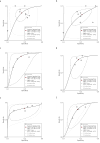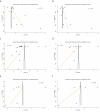Diagnostic and Prognostic Values of S100B versus Neuron Specific Enolase for Traumatic Brain Injury; a Systematic Review and Meta-analysis
- PMID: 38572218
- PMCID: PMC10988180
- DOI: 10.22037/aaem.v12i1.2222
Diagnostic and Prognostic Values of S100B versus Neuron Specific Enolase for Traumatic Brain Injury; a Systematic Review and Meta-analysis
Abstract
Introduction: Traumataic brain injury (TBI) represents a significant global health burden. This systematic review delves into the comparison of S100B and Neuron-Specific Enolase (NSE) regarding their diagnostic and prognostic accuracy in TBI within the adult population.
Methods: Conducted on October 21, 2023, the search identified 24 studies encompassing 6454 adult patients. QUADAS-2 and QUAPAS tools were employed to assess the risk of bias. The analyses aimed to evaluate the diagnostic and prognostic performance of S100B and NSE based on sensitivity, specificity, and area under the curve (AUC). The outcomes were detecting intracranial injury, mortality, and unfavorable outcome.
Results: Pooled data analysis tended towards favoring S100B for diagnostic and prognostic purposes. S100B exhibited a diagnostic AUC of 0.74 (95% confidence interval (CI): 0.70-0.78), sensitivity of 80% (95% CI: 63%-90%), and specificity of 59% (95% CI: 45%-72%), outperforming NSE with an AUC of 0.66 (95% CI: 0.61-0.70), sensitivity of 74% (95% CI: 53%-88%), and specificity of 46% (95% CI: 24%-69%). Notably, both biomarkers demonstrated enhanced diagnostic value when blood samples were collected within 12 hours post-injury. The analyses also revealed the excellent diagnostic ability of S100B with a sensitivity of 99% (95% CI: 4%-100%) and a specificity of 76% (95% CI: 51%-91%) in mild TBI patients (AUC = 0.89 [0.86-0.91]). In predicting mortality, S100B showed a sensitivity of 90% (95% CI: 65%-98%) and specificity of 61% (95% CI: 39%-79%), slightly surpassing NSE's performance with a sensitivity of 88% (95% CI: 76%-95%) and specificity of 56% (95% CI: 47%-65%). For predicting unfavorable outcomes, S100B exhibited a sensitivity of 83% (95% CI: 74%-90%) and specificity of 51% (95% CI: 30%-72%), while NSE had a sensitivity of 80% (95% CI: 64%-90%) and specificity of 59% (95% CI: 46%-71%).
Conclusion: Although neither biomarker has shown promising diagnostic performance in detecting abnormal computed tomography (CT) findings, they have displayed acceptable outcome prediction capabilities, particularly with regard to mortality.
Keywords: Brain Injuries; S100 Calcium Binding Protein Beta Subunit; S100 Proteins; Traumatic; Traumatic; Brain Concussion; Brain Contusion; Brain Hemorrhage.
Conflict of interest statement
None of the authors has any conflict of interest to declare.
Figures




Similar articles
-
Diagnostic Accuracy of S100B in Predicting Intracranial Abnormalities on CT Imaging Following Mild Traumatic Brain Injury: A Systematic Review and Meta-analysis.Neurocrit Care. 2025 Jun;42(3):1025-1042. doi: 10.1007/s12028-024-02189-7. Epub 2025 Jan 7. Neurocrit Care. 2025. PMID: 39776345
-
Point-of-Care Platform Blood Biomarker Testing of Glial Fibrillary Acidic Protein versus S100 Calcium-Binding Protein B for Prediction of Traumatic Brain Injuries: A Transforming Research and Clinical Knowledge in Traumatic Brain Injury Study.J Neurotrauma. 2020 Dec 1;37(23):2460-2467. doi: 10.1089/neu.2020.7140. Epub 2020 Sep 14. J Neurotrauma. 2020. PMID: 32854584 Free PMC article.
-
Prognostic Value of Serum Levels of S100 Calcium-Binding Protein B, Neuron-Specific Enolase, and Interleukin-6 in Pediatric Patients with Traumatic Brain Injury.World Neurosurg. 2018 Oct;118:e534-e542. doi: 10.1016/j.wneu.2018.06.234. Epub 2018 Jul 6. World Neurosurg. 2018. PMID: 30257306
-
Diagnostic value of S100B and neuron-specific enolase in mild pediatric traumatic brain injury.J Neurosurg Pediatr. 2009 Oct;4(4):339-44. doi: 10.3171/2009.5.PEDS08481. J Neurosurg Pediatr. 2009. PMID: 19795965
-
Update on the role of S100B in traumatic brain injury in pediatric population: a meta-analysis.Childs Nerv Syst. 2024 Nov;40(11):3745-3756. doi: 10.1007/s00381-024-06565-8. Epub 2024 Aug 23. Childs Nerv Syst. 2024. PMID: 39177800 Free PMC article.
Cited by
-
A Glance at Archives of Academic Emergency Medicine Journal in 2024.Arch Acad Emerg Med. 2024 Nov 19;13(1):e0. doi: 10.22037/aaem.v13i1.2571. eCollection 2025. Arch Acad Emerg Med. 2024. PMID: 40487906 Free PMC article. No abstract available.
-
Global diagnostic accuracy and prognostic value of non-contrast CT in acute traumatic brain injury: a systematic review and meta-analysis.Emerg Radiol. 2025 Aug 29. doi: 10.1007/s10140-025-02380-z. Online ahead of print. Emerg Radiol. 2025. PMID: 40879714 Review.
-
Long-term potentiation and long-term depression are both impaired afterin vitrostretch injury measured with stretchable microelectrode arrays.Biomed Phys Eng Express. 2025 Jul 14;11(4):045029. doi: 10.1088/2057-1976/adea7e. Biomed Phys Eng Express. 2025. PMID: 40592347 Free PMC article.
-
Advances in development of biomarkers for brain damage and ischemia.Mol Biol Rep. 2024 Jul 13;51(1):803. doi: 10.1007/s11033-024-09708-x. Mol Biol Rep. 2024. PMID: 39001884 Free PMC article. Review.
References
-
- Parikh S, Koch M, Narayan RK. Traumatic brain injury. International anesthesiology clinics. 2007;45(3):119–35. - PubMed
-
- Dinsmore J. Traumatic brain injury: an evidence-based review of management Continuing Education in Anaesthesia. Critical Care & Pain. 2013;13(6):189–95.
-
- Laalo JP, Kurki TJ, Sonninen PH, Tenovuo OS. Reliability of diagnosis of traumatic brain injury by computed tomography in the acute phase. J Neurotrauma. 2009;26(12):2169–78. - PubMed
Publication types
LinkOut - more resources
Full Text Sources
Miscellaneous
